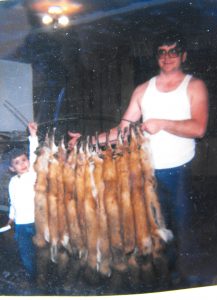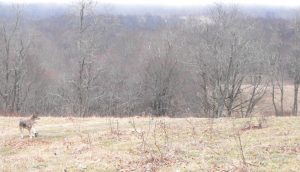Varmints and the Trapper
12-19-18
Copyright
Walt Hampton
Growing up and living in rural America, and especially in the central Appalachians, puts folks in close contact with the abundant wildlife populations. Folks that grew up in the city environment have no experience with the interactions with animals we mountain folk so often take for granted. The interface between humans and wild animals can sometimes become contentious, and we see this potential conflict acted out both in the countryside and the suburban or urban areas. My experience, being raised on the farm and in the outdoor environment, was that we categorized wildlife into three general groups: game, non-game and varmints. Game animals and birds we utilized and managed; non-game we enjoyed and generally tried to encourage; and varmints, the nuisance animals and birds that interfered or competed with our living objectives, we controlled. Because of population growth and urban sprawl, and the negative interactions that invariably result when people and wildlife are thrust together, we now see animals and birds that may have originally been considered to be within the first two categories fall into the varmint or nuisance group. I am afraid I will have to be the one to crush your ‘Walt Disney’ wildlife dreams right now, because even though they can be joyous childhood entertainment, they are, in the adult world, dangerous fantasy: the reality is that when people and wildlife come into conflict people can be hurt and animals die. The only path for thinking, caring folks to take is one of proper management of wildlife, to minimize the conflicts and insure survival of both the humans and wild creatures. This is why I dedicated my life to wildlife conservation, as a professional wildlife biologist with over 40 years of service in state and federal conservation agencies and as a consulting biologist for private interests, after receiving my degree from the University of Tennessee Knoxville in 1977. Wildlife is my life.
When I worked for the Virginia Department of Game and Inland Fisheries (VDGIF) part of my assigned work duty was nuisance wildlife control in the 11 far southwestern counties of the state. On various occasions during those years I instituted management and mitigation between people and raccoons, deer, bear, coyotes, opossums, skunks, weasels, mink, beaver, muskrat, ospreys, Canada geese, eagles, hawks, owls, squirrels, snakes, pigeons, woodpeckers and starlings. If you think certain animals are universally loved, you’ve never heard a gang of millennial parents scream about the Canada goose crap their kids step in, in the school playground or city park, or a 75-year-old grandmother demand to borrow a gun so she can shoot the “damn deer” that are eating her azaleas on her manicured housing-development lawn. Thank heaven for that grand lady by the way, who took her case before the state legislature, for she alone may have been responsible for the urban archery seasons that are such a success across the state today, keeping whitetail deer in check in so many towns and cities. When one’s child is attacked at the bus stop by a rutting buck, or a rabid raccoon or hungry coyote, you see priorities regarding wildlife change very quickly. Certainly the news over the last year has been full of similar stories, from the Disney Resort and alligators to suburban Seattle and mountain lions. When proper reasonable management gives way to political correctness people are hurt or killed. As far as I am concerned, there is no excuse for that. Fifty years ago, when my Aunt Mae found out that a weasel had killed her chickens I was drafted to be the weasel trapper; the weasel went to the fur shed and the problem went away.
I began fox, bobcat and raccoon trapping in earnest in 1978 when fur prices were high, to bolster our tiny family income, but it was really more than that—nothing can teach you more about certain species of wildlife and how they interact with their environment than the ancient art of trapping, and there are specific techniques that are used for specific species of furbearers. Currently Cecelia and I are still in the process of filling the freezers with venison, but I am looking forward to getting some coyote traps into the ground very soon. The coyote, a non-native animal in Virginia, has become well-established and is now present in every county in the state. Certainly worthy of admiration for its wonderful adaptability, it has none-the-less become a terrible nuisance and is so classified by the state Game Department. Our native gray fox and his red cousin have almost disappeared across southwest Virginia due to coyote predation (the red fox is not native in America, having been imported in the 18th century from England) and the toll this new invasive canine takes on small pets, deer fawns, ground-nesting birds and other native wildlife is enormous. The most efficient method of coyote control is through trapping and I look forward every winter to trying to reduce the population on several farms where I have been invited to trap.
Consistently successful coyote trapping is dependent on a narrow focus and attention to detail. With thousands of acres out there you are attempting to get that animal to step on a spot smaller than a canning jar lid; and the animal you are attempting to take is arguably the most intelligent and careful predator on the American landscape. The traps must be tuned, boiled, dyed and waxed, properly attached to the anchor and scent-free. They must be handled with rubber gloves to limit human odor and the set must be carefully made to exclude non-target animals. Mastering proper trapping technique is challenging hard work and calls for an intimate knowledge of the habitat and habits of the target animal.
Fur is a renewable resource; with all the hoopla these days bemoaning fossil fuel, I find it ironic those that would lambast trapping are the same folks that promote synthetic fur, which of course is made from petroleum. Trapping provides research data on furbearing animal populations that we otherwise would not have, helping the wildlife professionals make informed decisions on management of these animals and habitats. For me, trapping is also a connection with the early Appalachian and American explorers, those folks that opened up the wilderness, and it predicated the first interactions between European settlers and the Native Americans; in this way trapping laid the foundation for our republic. Trapping was an indispensible part of Appalachian culture for the farm folks that wrestled their livings from these mountains and because of that cultural heritage I taught my sons to trap; and I have confidence that they will teach their children likewise. Whether for fur or for control of varmints, I am proud to call myself a trapper. I would be delighted to share this world with you.
If you are interested in learning more about the fascinating world of trapping I would suggest you contact your state trappers association or state wildlife department, and I would be happy to answer any of your questions, you may direct them to me through Kelley St. Germain and I will answer them publicly on the facebook page for Appalachian Memory Keepers.






